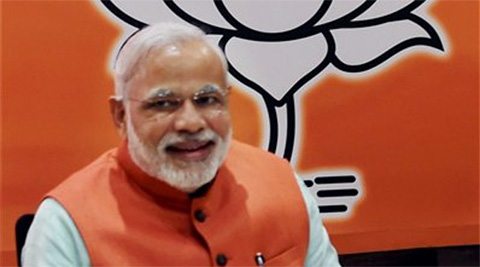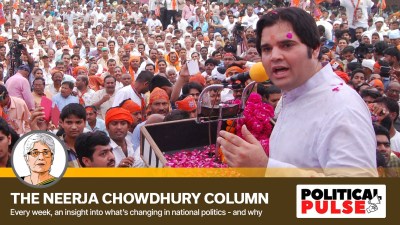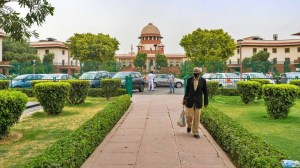- India
- International
They gave Modi a walkover
Modi has a map for the future. Regional chieftains only have a Tughlaqesque politics.
 The BJP has understood the reality of India’s changing society. An organisation that was considered Brahmin-centric put up a backward caste leader like Narendra Modi as its prime ministerial candidate.
The BJP has understood the reality of India’s changing society. An organisation that was considered Brahmin-centric put up a backward caste leader like Narendra Modi as its prime ministerial candidate.
By: Shivanand Tiwari
The results of the Haryana and Maharashtra assembly elections sound a warning for regional parties. In Maharashtra, the BJP did have an organisational base. But in Haryana, it had nothing. In that state, it hadn’t ever bagged more than six seats. What could be the reason, then, for such incredible outcomes in these two states? To begin with, it seems that the voters now seek change not just at the Centre but also in the state. They feel that having a government of the same political colour at the Centre and in the state is necessary for development, that both governments will then cooperate to take the state forward and there will be no conflict between them. But that is not the only reason for the aspiration for change that is visible in the states today.
Ever since 1967, we have had the phenomenon of the state and Central governments being of different political hues. But the big transformation came after 1990, with the implementation of the Mandal Commission report. The Congress dug its own political grave in north India with its opposition to Mandal — it was more or less decimated in Uttar Pradesh and Bihar. At the same time, upper caste dominance of the politics of north India waned. After the V.P. Singh government brought in Mandal, the BJP acquired an anti-Muslim and anti-backward image because it pulled out support from the government and L.K. Advani set out on the rath yatra to Ayodhya on the Ram Mandir issue. That is the reason why, till the last Lok Sabha elections, the BJP’s very existence in UP seemed endangered as power alternated between Mulayam Singh Yadav and Mayawati. In Bihar, it was mainly with the support of Nitish Kumar’s backward caste base that the NDA could form the government in 2005 after displacing a strong leader like Lalu Prasad.
After the Maharashtra and Haryana verdicts, however, the future of these regional chieftains of an earlier time has come under discussion. Can they hold up before the Modi wave? The reason for scepticism about these leaders becomes clear if you look carefully at their style of functioning. Each and every one of them runs his respective party and government in Tughlaqesque ways. Their word is law. They have nurtured neither party organisation nor policy. In the name of social justice, they have only flaunted backwardism, and a Congress-style Muslim vote bank politics has passed for secularism. The worst hunger, malnutrition and poverty is to be found in the sections these leaders have turned into captive vote banks in order to perpetuate themselves in power. It is true that these sections have got some space in society because of the social justice movement. But they now need economic justice. They also have a yearning to improve their own economic circumstances. Their younger generation has not seen upper caste sway and exploitation in the same way. A consumerist culture has changed the way they dream. But the agenda of those who have ruled for 24-25 years on the strength of their vote has not changed. The “secularism” of these parties is alienating Hindus. The result is that in the recent Lok Sabha elections, a large number of Hindus voted as Hindus.
On the other hand, the BJP and the Sangh have understood the reality of India’s changing society and an organisation that was considered Brahmin-centric put up a backward caste leader like Narendra Modi as its prime ministerial candidate. Modi is not an ordinary man. The journey of this man, who began earning his living by selling tea, to the prime minister’s chair is no less than that of the hero of a novel. I had warned Nitish that Modi is not an ordinary man, he must not be underestimated. In return, he not only turned me out of the Rajya Sabha, but also expelled me from the party. This is the Tughlaqesque style of running party and government.

Nitish lacks the judgement and even the courage to take the right step at the right time. Ahead of the 2010 assembly elections in Bihar, when Modi had come to Patna for the BJP national executive, Nitish had withdrawn his dinner invitation to the BJP at the last minute. No one had expected such discourtesy from one who is known to be civil in his conduct. Yet the most surprising thing was that even after that episode, he continued to be part of the NDA. If at that time, Nitish had separated from the NDA and fought the assembly election on his own, the situation would have been very different. The Lok Sabha results from Bihar have confirmed that Nitish is in a world of his own. He has lost touch with ground reality.
The political character of Uttar Pradesh and Bihar is similar. In both states, only casteism and Muslim vote bank politics have been practised in the name of social justice and secularism. The fact that Modi belongs to a backward caste has punctured the balloon of these so-called leaders of social justice. The BJP’s large victory in the Lok Sabha polls would not have been possible without the support of backward castes to the party. In the same way, post-poll surveys tell us that about 8 per cent of the Muslim vote, nation-wide, went to the NDA. In my estimation, this must certainly have happened in the Maharashtra election as well.
The Muslim in India is sick of the politics of fake secularism. Self-styled secular leaders push Muslims to the front in their purported fight against communalism. As a result, Muslims become the target for the opponents of these parties. Now the Muslims are watching Modi carefully. So far, Prime Minister Modi has not made any statement that can be construed to be anti-Muslim. People also sense that for Modi’s dreams — and for those that he is selling — to come true, peace and amity between communities and citizens is a prerequisite.
Modi seems to have a vision. He places a map of the nation’s future before the people. We could disagree with that vision, or that map. But the Maharashtra and Haryana elections have proved that people have faith in him. The biggest thing is that the vast section of youth that is disillusioned on all counts and fearful about its future wants to test Modi’s developmental claim, give him a chance. This section is not worried about caste or religion, but about its own future. At the moment, it does not see another leader apart from Modi who is concerned about it. That is why even in the states, this section is voting in governments that can work with Modi. And that is why I see no reason for even the results in the forthcoming assembly polls in Jharkhand and Bihar to be any different.
The writer is a former Rajya Sabha MP and was a member of the JD(U) till February 2014
express@expressindia.com
EXPRESS OPINION
Apr 25: Latest News
- 01
- 02
- 03
- 04
- 05










































